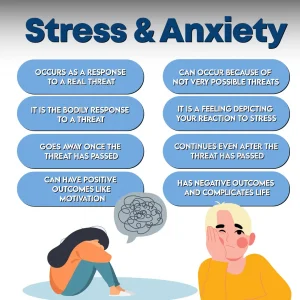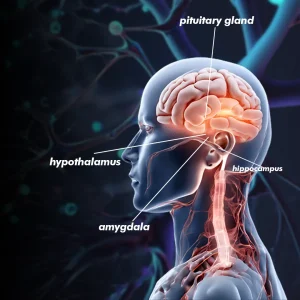Neuphony Research Team | Published on October 5, 2024 | 5 Mins Read
The concept of stress and anxiety seems to be common, with many people facing increased incidences of these conditions. The ability to report how these phenomena affect the brain and the body, and how neuroscience research helps prevent or minimize them, can contribute significantly to the awareness of the issue or population. Stress is a perceived reaction by an individual to an event or demand that may cause an uncomfortable body condition. When our bodies perceive a situation as threatening or environmentally stressful, they initiate the so-called fight-or-flight response. This causes the evoke the release of stress hormones such as cortisol and adrenaline that prepare the attack or escape.
Anxiety differs from fear in that stress and anxiety are chronic and cumulative worries or fears that are not directed at an identifiable stressful object or situation. Fear is a particular kind of expectation that comes as a kind of light arousal coupled with apprehension most of the time about future events. People often confuse anxiety and stress, using the two words interchangeably. However, stress is a reaction to a specific event, while anxiety is more general and chronic. The discovery of the role of different parts of the brain in stress has been made by neuroscience research over the years.
We experience this sort of situation when the hypothalamus which is a very small region of the base of the brain activates the pituitary gland which in turn activates the adrenal glands to release cortisol. This hormone is useful especially in terms of managing stress since it regulates the amount of blood sugar in the body as well as diminishing the activity of other processes such as digestion and immune function. But the repeated stress causes the release of a large amount of cortisol in the body and the same neurotransmitter interferes with the normal functioning of the brain and other systems in the body. Increased levels of cortisol will directly affect the hippocampus for learning and memory proceeding. This can alter one’s thinking ability and also cause psychological disorders.
It is vital to explore and comprehend the relationship between the brain and stress and anxiety in the ever-growing and fast-moving science of neuroscience research. Neuroscience of stress and anxiety: brain function and highlighting these conditions is one of the most important and discussed issues. This particular exploration seeks to look at the neural connections involved, and the physical responses that are elicited to help in the understanding of how stress and anxiety relief can be controlled and managed with the help of CBT. Stress is a complex emotional response comprising several components originating from different areas of the brain.

The brain identifies a stressor and triggers the HPA axis in response. This pathway starts in the hypothalamus, which then releases corticotropin-releasing hormone (CRH). CRH activates the pituitary gland, prompting it to release adrenocorticotropic hormone (ACTH) into the bloodstream. ACTH stimulates the adrenal glands to produce cortisol. Cortisol plays a multifaceted role, including regulating metabolism, reducing inflammation, and controlling the sleep-wake cycle.
However, chronic stress from a negative environment or job can lead to prolonged cortisol production. This disrupts these vital processes and contributes to anxiety, depression, and cardiovascular disease.
Recent scientific studies reveal a link between stress and changes in the amygdala, hippocampus, and prefrontal cortex. The amygdala, responsible for emotions and memory, becomes hyperactive under stress, intensifying fear and anxiety. The hippocampus, involved in memory formation, can be negatively affected by high cortisol levels, potentially leading to amnesia or impaired learning. The prefrontal cortex, which governs our executive functions and decision-making abilities, becomes underactive under stress, increasing the risk of anxiety. Anxiety disorders, a prevalent group of mental illnesses, are strongly associated with the body’s stress response.

Anxiety is a psychological condition that is highly prevalent and encompasses millions of people. A persistent fear and constant worrying can affect one’s daily life. Emotional and physical stress seems intertwined with the mechanisms of the brain that contribute to anxiety. Stress is the reaction of the body to a situation in which the body decides that it needs something from it. People experience depression as a prolonged period of sadness and distress, even when there’s no apparent reason for it. Anxiety arises when people feel uneasy and apprehensive in response to a perceived threat.
The research in the neuroscience field has also helped in explaining the way stress leads to the development of anxiety and also the changes in the brain areas of an individual having anxiety disorders. The brain’s hypothalamus triggers the HPA axis (or adrenal glands) which instructs the adrenal glands to release the body’s major stress hormone, cortisol. Cortisol mobilizes the body for fight-or-flight by ramping up heart rate, blood pressure, and glucose production, along with other effects.
This is a vital response that helps the body continue with its survival but prolonged stress causes abnormalities in the HPA axis such that the cortisol levels in the brain remain high and this hurts the brain. There is a significant neuroanatomical difference in the brains of persons who experience anxiety brain function as compared to those who do not. The amygdala, prefrontal regions, and hippocampus actively participate in the brain’s processing of anxiety on a structural level. The almond-shaped amygdala plays a critical role in processing fear within the brain. That is why it tracks threats and triggers the HPA axis. The amygdala of anxious individuals typically fires at does at inappropriate times and creates fear from situations that are not dangerous.
The anterior cingulate (AC) evaluates conflict and task performance, while the dorsolateral prefrontal cortex (dlPFC) handles task switching and working memory. Stress can impact the brain region connecting the PFC and the amygdala, leading to debilitating stress responses. The hippocampus is a section of the brain that is important in the process of storage and recall of memories; deterioration of the hippocampus is, therefore, associated with chronic stress and anxiety which results in deterioration of memory and cognition of learning processes.